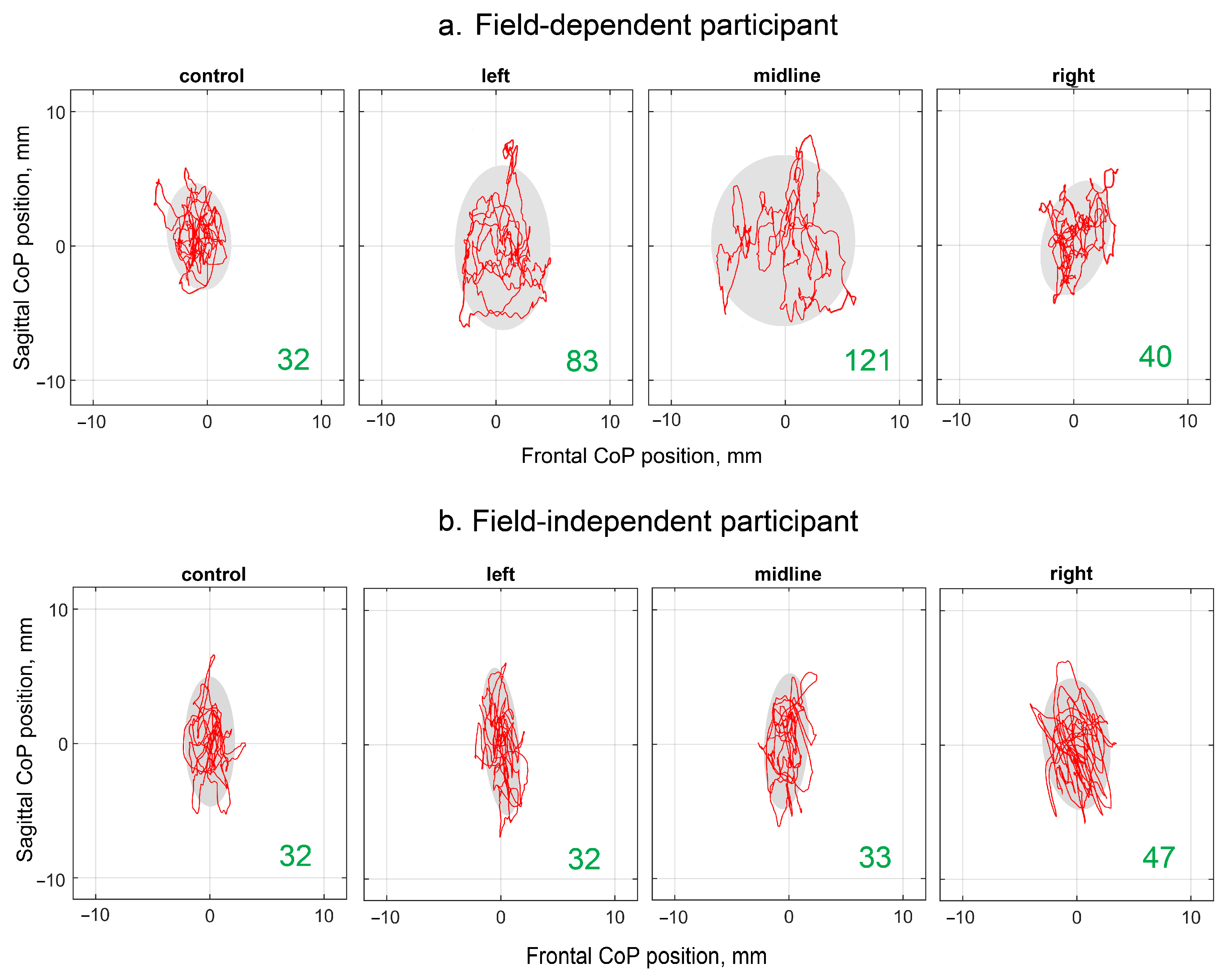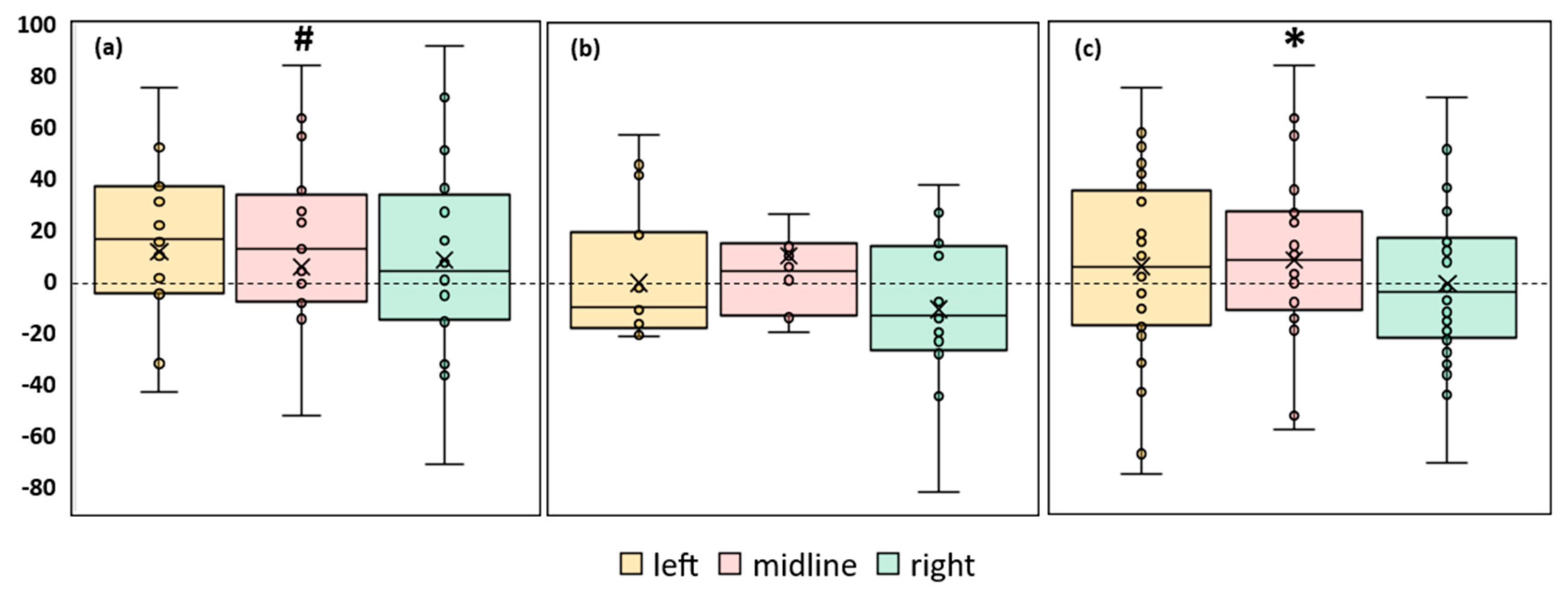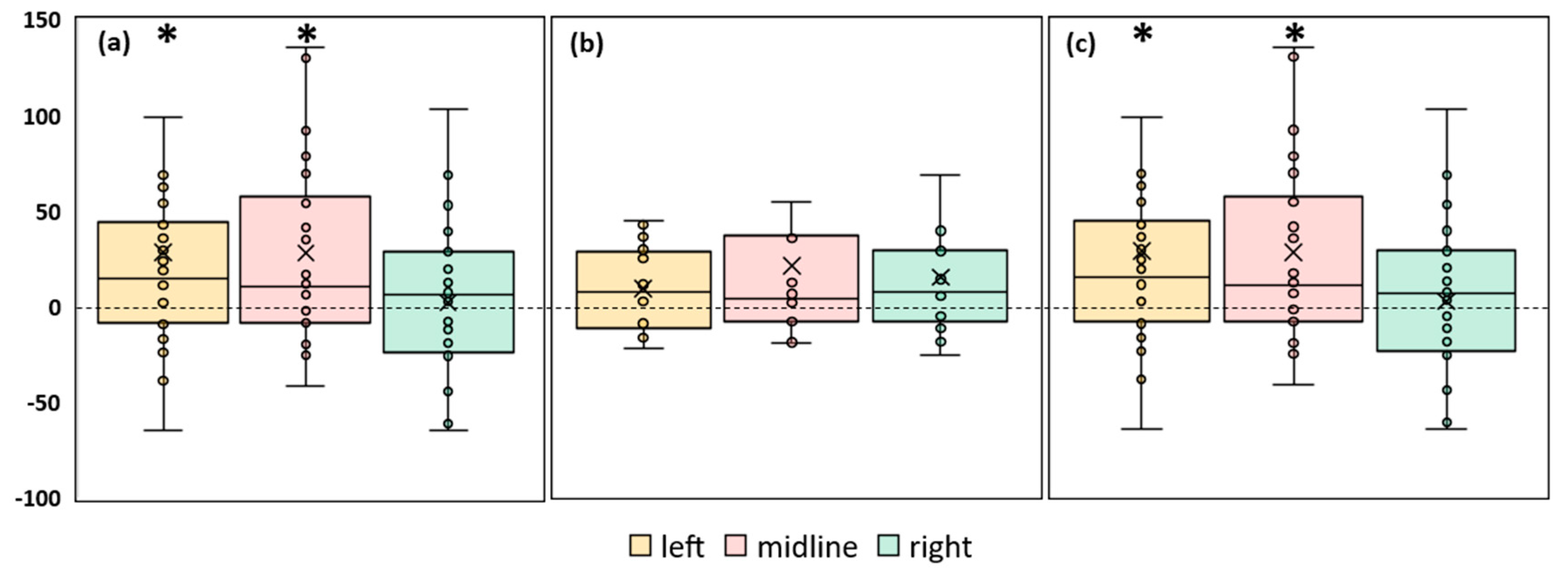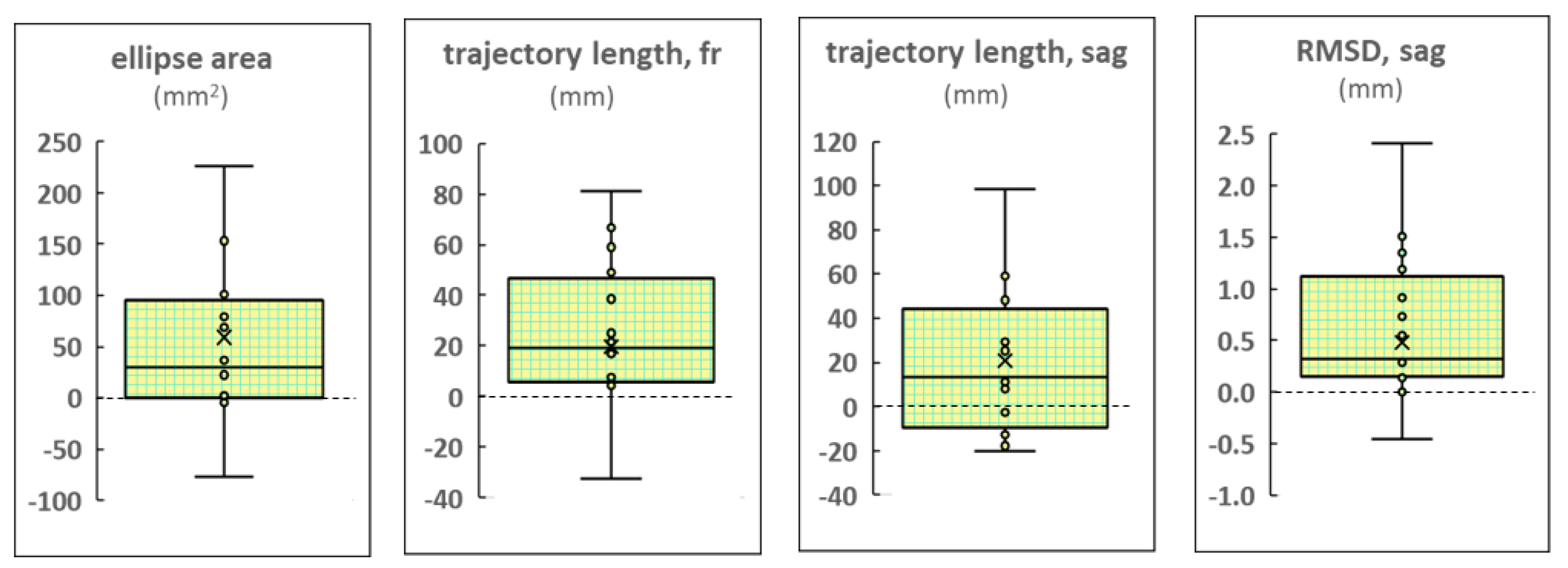Posture of Healthy Subjects Modulated by Transcutaneous Spinal Cord Stimulation
Abstract
:1. Introduction
1.1. Spinal Cord Stimulation as a Tool to Study Postural Control
1.2. Different Roles of Flexors and Extensors in Postural Control
1.3. Cognitive Style Influences Coordination of Body Segments in Postural Control
1.4. Purpose and Hypothesis of the Study
2. Materials and Methods
2.1. Participants
2.2. Procedure and Task
2.3. Stabilometry
2.4. Transcutaneous Electrical Stimulation of the Spinal Cord and Dorsal Roots
2.5. Analysis
2.5.1. Stabilometry Indicators
2.5.2. Statistics
3. Results
3.1. Cognitive Style—CoP Parameters without tES
3.2. Current Intensities
3.3. CoP Parameters in Experimental Conditions
3.3.1. Length of the CoP trajectory
3.3.2. Ellipse Area
3.3.3. RMSD of the CoP
3.3.4. Differences in CoP Parameters between Left and Right tES
4. Discussion
4.1. Differences in Postural Control Responses to Spinal Test of Patients with Motor Disorders and Healthy Subjects
4.2. Upright Posture of FD Participants Responded to Spinal tES and That of FI Participants Did Not
4.3. Left and Right Spinal Root tES Had Different Effects on Postural Balance
4.4. “Posture” and “Equilibrium” Tasks during Standing and Spinal tES
4.5. Limitations
5. Conclusions
Supplementary Materials
Author Contributions
Funding
Institutional Review Board Statement
Informed Consent Statement
Data Availability Statement
Acknowledgments
Conflicts of Interest
References
- Gerasimenko, Y.P.; McKinney, Z.; Sayenko, D.G.; Gad, P.; Gorodnichev, R.M.; Grundfest, W.; Edgerton, V.R.; Kozlovskaya, I.B. Spinal and sensory neuromodulation of spinal neuronal networks in humans. Hum. Physiol. 2017, 43, 492–500. [Google Scholar] [CrossRef]
- Musienko, P.; Courtine, G.; Tibbs, J.E.; Kilimnik, V.; Savochin, A.; Garfinkel, A.; Roy, R.R.; Edgerton, V.R.; Gerasimenko, Y.; Gad, P.N.; et al. Somatosensory control of balance during locomotion in decerebrated cat. J. Neurophysiol. 2012, 107, 2072–2082. [Google Scholar] [CrossRef] [PubMed]
- Gorodnichev, R.M.; Pivovarova, E.A.; Puhov, A.; Moiseev, S.A.; Savochin, A.A.; Moshonkina, T.R.; Chsherbakova, N.A.; Kilimnik, V.A.; Selionov, V.A.; Kozlovskaya, I.B.; et al. Transcutaneous electrical stimulation of the spinal cord: A noninvasive tool for the activation of stepping pattern generators in humans. Hum. Physiol. 2012, 38, 158–167. [Google Scholar] [CrossRef]
- Mendez, A.; Islam, R.; Latypov, T.; Basa, P.; Joseph, O.J.; Knudsen, B.; Siddiqui, A.M.; Summer, P.; Staehnke, L.J.; Grahn, P.J.; et al. Segment-Specific Orientation of the Dorsal and Ventral Roots for Precise Therapeutic Targeting of Human Spinal Cord. Mayo Clin. Proc. 2021, 96, 1426–1437. [Google Scholar] [CrossRef] [PubMed]
- Sayenko, D.G.; Rath, M.; Ferguson, A.R.; Burdick, J.W.; Havton, L.A.; Edgerton, V.R.; Gerasimenko, Y.P. Self-Assisted Standing Enabled by Non-Invasive Spinal Stimulation after Spinal Cord Injury. J. Neurotrauma 2019, 36, 1435–1450. [Google Scholar] [CrossRef] [PubMed]
- Moshonkina, T.; Grishin, A.; Bogacheva, I.; Gorodnichev, R.; Ovechkin, A.; Siu, R.; Edgerton, V.R.; Gerasimenko, Y. Novel Non-invasive Strategy for Spinal Neuromodulation to Control Human Locomotion. Front. Hum. Neurosci. 2021, 14, 622533. [Google Scholar] [CrossRef] [PubMed]
- Ivanenko, Y.; Gurfinkel, V.S. Human Postural Control. Front. Neurosci. 2018, 12, 171. [Google Scholar] [CrossRef]
- Phillips, L.H.; Park, T.S. Electrophysiologic mapping of the segmental anatomy of the muscles of the lower extremity. Muscle Nerve 1991, 14, 1213–1218. [Google Scholar] [CrossRef]
- Woollacott, M.; Shumway-Cook, A. Attention and the control of posture and gait: A review of an emerging area of research. Gait Posture 2002, 16, 1–14. [Google Scholar] [CrossRef]
- Field Dependence-Independence: Bio-Psycho-Social Factors across the Life Span; Wapner, S.; Demick, J. (Eds.) Psychology Press: New York, NY, USA, 2014. [Google Scholar] [CrossRef]
- Isableu, B.; Ohlmann, T.; Crémieux, J.; Amblard, B. Selection of spatial frame of reference and postural control variability. Exp. Brain Res. 1997, 114, 584–589. [Google Scholar] [CrossRef]
- Isableu, B.; Ohlmann, T.; Crémieux, J.; Amblard, B. Differential approach to strategies of segmental stabilisation in postural control. Exp. Brain Res. 2003, 150, 208–221. [Google Scholar] [CrossRef] [PubMed]
- Timofeeva, O.P.; Andreeva, I.G. Postural Control Features of Field-Dependent and Field-Independent Subjects in the Absence of Visual and Audio Information. Hum. Physiol. 2021, 47, 374–381. [Google Scholar] [CrossRef]
- Moshonkina, T.R.; Shandybina, N.D.; Moiseev, S.A.; Grishin, A.A.; Gerasimenko, Y.P. Muscle Coactivation Phenomenon in the Modulation of Walking by Electrical Stimulation of the Spinal Cord. Hum. Physiol. 2021, 47, 175–182. [Google Scholar] [CrossRef]
- Latash, M.L. Muscle coactivation: Definitions, mechanisms, and functions. J. Neurophysiol. 2018, 120, 88–104. [Google Scholar] [CrossRef]
- Morasso, P.G.; Sanguineti, V.; Cos, I.; Medleg, F.; Cisek, P.; Roy, A.; Krebs, H.I.; Bever, C.T.; Forrester, L.W.; Macko, R.F.; et al. Ankle Muscle Stiffness Alone Cannot Stabilize Balance During Quiet Standing. J. Neurophysiol. 2002, 88, 2157–2162. [Google Scholar] [CrossRef] [PubMed]
- Paillard, T.; Noé, F. Does monopedal postural balance differ between the dominant leg and the non-dominant leg? A review. Hum. Mov. Sci. 2020, 74, 102686. [Google Scholar] [CrossRef]
- Hayes, J.; Allinson, C.W. Cognitive Style and its Relevance for Management Practice. Br. J. Manag. 1994, 5, 53–71. [Google Scholar] [CrossRef]
- Sliva, S.S. Domestic Computer Stabilography: Engineering Standards, Functional Capabilities, and Fields of Application. Biomed. Eng. 2005, 39, 31–34. [Google Scholar] [CrossRef]
- García, A.M.; Serrano-Muñoz, D.; Taylor, J.; Avendaño-Coy, J.; Gómez-Soriano, J. Transcutaneous Spinal Cord Stimulation and Motor Rehabilitation in Spinal Cord Injury: A Systematic Review. Neurorehabilit. Neural Repair 2019, 34, 3–12. [Google Scholar] [CrossRef]
- Rahman, A.; Tharu, N.S.; Gustin, S.M.; Zheng, Y.-P.; Alam, M. Trans-Spinal Electrical Stimulation Therapy for Functional Rehabilitation after Spinal Cord Injury: Review. J. Clin. Med. 2022, 11, 1550. [Google Scholar] [CrossRef]
- Gad, P.; Hastings, S.; Zhong, H.; Seth, G.; Kandhari, S.; Edgerton, V.R. Transcutaneous Spinal Neuromodulation Reorganizes Neural Networks in Patients with Cerebral Palsy. Neurotherapeutics 2021, 18, 1953–1962. [Google Scholar] [CrossRef] [PubMed]
- Roberts, B.W.; Atkinson, D.A.; Manson, G.A.; Markley, R.; Kaldis, T.; Britz, G.W.; Horner, P.J.; Vette, A.H.; Sayenko, D.G. Transcutaneous spinal cord stimulation improves postural stability in individuals with multiple sclerosis. Mult. Scler. Relat. Disord. 2021, 52, 103009. [Google Scholar] [CrossRef] [PubMed]
- Zelenin, P.V.; Orlovsky, G.N.; Deliagina, T.G.; Lavrov, I.; Burdick, J.; Zhong, H.; Hsu, L.-J.; Musienko, P.; Courtine, G.; Tibbs, J.E.; et al. Facilitation of Postural Limb Reflexes With Epidural Stimulation in Spinal Rabbits. J. Neurophysiol. 2010, 103, 1080–1092. [Google Scholar] [CrossRef]
- Carrera, R.M.; Omofuma, I.; Yasin, B.; Agrawal, S.K. The Effect of Transcutaneous Spinal Cord Stimulation on Standing Postural Control in Healthy Adults. IEEE Robot. Autom. Lett. 2022, 7, 8268–8275. [Google Scholar] [CrossRef]
- Omofuma, I.; Carrera, R.; King-Ori, J.; Agrawal, S.K. Effect of Transcutaneous Spinal Cord Stimulation on Balance and Neurophysiological Characteristics in Young Healthy Adults. TechRxiv 2023. [Google Scholar] [CrossRef]
- Witkin, H.A.; Asch, S.E. Studies in space orientation. IV. Further experiments on perception of the upright with displaced visual fields. J. Exp. Psychol. 1948, 38, 762–782. [Google Scholar] [CrossRef]
- Vidal, P.-P.; Lacquaniti, F. Perceptual-motor styles. Exp. Brain Res. 2021, 239, 1359–1380. [Google Scholar] [CrossRef]
- de Freitas, P.B.; Freitas, S.M.; Duarte, M.; Latash, M.L.; Zatsiorsky, V.M. Effects of joint immobilization on standing balance. Hum. Mov. Sci. 2009, 28, 515–528. [Google Scholar] [CrossRef]
- Siu, R.; Brown, E.H.; Mesbah, S.; Gonnelli, F.; Pisolkar, T.; Edgerton, V.R.; Ovechkin, A.V.; Gerasimenko, Y.P. Novel Noninvasive Spinal Neuromodulation Strategy Facilitates Recovery of Stepping after Motor Complete Paraplegia. J. Clin. Med. 2022, 11, 3670. [Google Scholar] [CrossRef]
- Schorderet, C.; Hilfiker, R.; Allet, L. The role of the dominant leg while assessing balance performance. A systematic review and meta-analysis. Gait Posture 2020, 84, 66–78. [Google Scholar] [CrossRef]







| Participants | Ellipse Area, mm2 | RMSDfront, mm | RMSDsag, mm | |
|---|---|---|---|---|
| FD (N = 16) | 151 (86; 231) * | 3.1 (2.0; 3.7) * | 3.1 (2.3; 4.0) * | |
| FI (N = 16) | 56 (46; 102) | 1.6 (1.6; 2.6) | 2.4 (2.1; 2.7) | |
| All (N = 32) | 93 (50; 148) | 2.2 (1.6; 3.2) | 2.6 (2.1; 3.3) | |
| Participants | Left Dorsal Roots, mA | Midline, mA | Right Dorsal Roots, mA |
|---|---|---|---|
| FD (N = 8) | 21 ± 6 | 26 ± 13 | 21 ± 6 |
| FI (N = 8) | 20 ± 11 | 22 ± 12 | 19 ± 10 |
| All (N = 16) | 20 ± 11 | 24 ± 12 | 20 ± 10 |
Disclaimer/Publisher’s Note: The statements, opinions and data contained in all publications are solely those of the individual author(s) and contributor(s) and not of MDPI and/or the editor(s). MDPI and/or the editor(s) disclaim responsibility for any injury to people or property resulting from any ideas, methods, instructions or products referred to in the content. |
© 2023 by the authors. Licensee MDPI, Basel, Switzerland. This article is an open access article distributed under the terms and conditions of the Creative Commons Attribution (CC BY) license (https://creativecommons.org/licenses/by/4.0/).
Share and Cite
Shamantseva, N.; Timofeeva, O.; Gvozdeva, A.; Andreeva, I.; Moshonkina, T. Posture of Healthy Subjects Modulated by Transcutaneous Spinal Cord Stimulation. Life 2023, 13, 1909. https://doi.org/10.3390/life13091909
Shamantseva N, Timofeeva O, Gvozdeva A, Andreeva I, Moshonkina T. Posture of Healthy Subjects Modulated by Transcutaneous Spinal Cord Stimulation. Life. 2023; 13(9):1909. https://doi.org/10.3390/life13091909
Chicago/Turabian StyleShamantseva, Natalia, Olga Timofeeva, Alisa Gvozdeva, Irina Andreeva, and Tatiana Moshonkina. 2023. "Posture of Healthy Subjects Modulated by Transcutaneous Spinal Cord Stimulation" Life 13, no. 9: 1909. https://doi.org/10.3390/life13091909







